Creating Connections
Stories by Katrina Mitchell
Photos by Alexios Monopolis
What does a physician on the Dartmouth faculty have in common with an 84-year-old Hanover resident who can cook a mean batch of Cuban black beans? If you guessed medical care, you guessed right. If you guessed a shared passion for Cuban culture, Latin poetry, and Leonard Bernstein's West Side Story, then you've earned a bonus point.
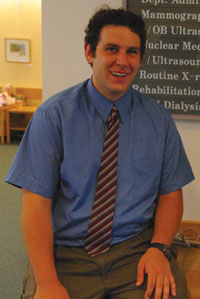
|
|
Gary Maslow conceived of the Patient Partnership Program, which . . . |
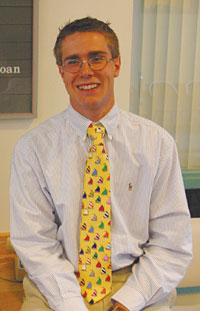
|
|
Nick Osborne helped to craft into a pilot program, for which . . . |
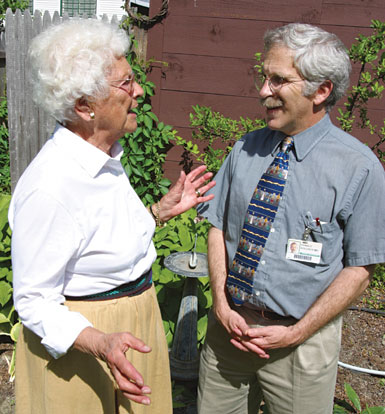
|
|
Don Kollisch (right—pictured with his patient partner, Dale Bryant) has served as one of the physician leaders . . . |
When Donald Kollisch, M.D., an associate professor of community and family medicine, became one of the physician leaders of DMS's Patient Partnership Program last year, he discovered that he didn't want to just facilitate group discussions about relating to patients on a human, personal level. He wanted to have a "patient partner" of his own. So he asked his friend and longtime patient Dale Bryant—whom he calls one of the "most lively people around"—to attend the program's meetings and speak about her experiences in life and with the medical system.
As Kollisch and Bryant talked with the students participating in the program—veering into discussions about their favorite books and their plans for a joint trip to Cuba—the doctors-to-be gained an appreciation for the value of long-term relationships with patients.
|
Kollisch believes that DMS's Patient Partnership Program—which pairs first- and second-year medical students with Upper Valley patients who have a range of medical conditions, from cancer to high-risk pregnancy—has provided a means for students to "stay whole and complex and find their way through the formidable and anxiety-provoking medical school experience." As the 20-plus students who participated in the program last year met over dinner—and agonized about their patients' struggles but also laughed about lighter moments in their lives—they came to realize that medicine is as much about wellness as it is about illness.
"This program doesn't force students to give patients a diagnosis," Kollisch explains. He feels that a program like this can restore the humanity and creativity that students sometimes lose sight of during the intensely academic experience of medical school. "Instead," Kollisch says, "it allows them to experience their patient's life and gain skills to be more effective caregivers."
The program's genesis
This opportunity to foster humanity in medicine is exactly what Gary Maslow, now a fourth-year medical student, envisioned during his first year at DMS. With the support of Joseph O'Donnell, M.D., senior advising dean and director of community programs at DMS, Maslow researched the feasibility of what eventually became the Patient Partnership Program. During his second year, he started up a pilot program, and he watched it expand and solidify into an official volunteer elective during the 2002-03 academic year.
|
Maslow (who wrote a feature titled "Lost Boys" for Dartmouth Medicine's Summer 2002 issue) believes that O'Donnell's encouragement was critical, because it legitimized Maslow's feeling that the traditional medical school curriculum often leads students to adopt a narrow scientific perspective on medical care. Furthermore, O'Donnell and Maslow agreed that the program could provide an opportunity for students to connect with the Upper Valley community and understand how illness affects entire families longitudinally—not just individual patients in the short term.
"We don't spend enough time learning about how illness can develop over time, and how things change, and how chaotic or wonderful this can be," Maslow explains. "That is something that was missing in my medical education: watching people change and develop."
After starting his studies at DMS, and spending so much time in the lecture hall and library, Maslow began to miss having the deep connections with patients that he'd had while volunteering at DHMC as a Dartmouth undergraduate. Maslow recalls one particular memory from those volunteer experiences to describe the impetus he felt to start the Patient Partnership Program.
Maslow and a friend had volunteered to help a cancer patient clean his house after the patient said he hadn't cleaned in five years. "When he said he hadn't cleaned in five years," relates Maslow, "he really hadn't cleaned. There was an inch of dust on everything." As the three of them were surveying the scene, the old man said, "I have a dirty secret." The man had been collecting New Yorker magazines since 1960—meaning to cut cartoons from them— and he needed Maslow to dispose of them. "Being connected to him in that way, he was more than a cancer patient. I saw who he was, and why. It was neat to have that kind of connection to him, to have a joke, and relate with him on a personal level," Maslow explains.
|
Realizing that he wanted other medical students to have an opportunity to know patients in this way, Maslow turned to Donna DiFillippo, coordinator of student affairs at DMS, and Toni LaMonica, manager of the Boyle Community Pediatrics Program at DHMC, to help him develop a plan.
Putting a pilot in place
Two more students—Nicholas Osborne, now in his third year at DMS, and Shilpa Lamba, then a DMS first-year who has since transferred to the Baylor School of Medicine—signed on to the project soon after. Under the auspices of an Albert Schweitzer Fellowship, they developed a six-part curriculum for the student participants, building on Maslow's original vision for the program. The resulting yearlong syllabus included monthly meetings and opportunities for students to reflect individually and as a group on their experiences with their patient partners.
Because the program is still in its developmental stages—after one year as a pilot and one as an official elective—there are still challenges to work out. For example, LaMonica explains that she and her colleagues want to make sure students continue to share their experiences in a group setting, but at the same time they want to keep the meetings unencumbered by too many academic requirements. Despite these ongoing adjustments, La- Monica says the key thing is that the curriculum is structured so it "speaks more to the art of medicine than the science of medicine, and honors medicine as a service profession that connects with families and communities."
DiFillippo, who helps match students with their patient partners and also facilitates meetings with Kollisch and Dan Collison, M.D., couldn't agree more with LaMonica's assessment of what makes the program special.
Having spent a significant amount of time as a patient herself when she had part of her colon removed last year, DiFillippo recognizes when a doctor expresses the type of empathy that the Patient Partnership Program is seeking to foster in medical students. She recalls one doctor who was "really present" in the room with her, when she otherwise would have felt alone and scared. "When you say good-bye to your friend in the waiting room and you go into the hospital room and a doctor comes in and holds your hand, you know that someone is looking out for you and honoring your fright and questions," DiFillippo explains.
The group experiences
Aside from allowing students to follow their patients' lives outside the medical realm, the Patient Partnership Program also aims to foster peer support among students. Kollisch recalls a time last spring when Lamba called a special meeting of the group, knowing that Rebecca Cogswell was going through a particularly stressful and frightening time with her patient partner, Kathy Boisvert. Kollisch believes that Lamba's awareness of her friend's struggle is just one example of the spirit of community that has been generated by the Patient Partnership Program.
|
"The most gratifying thing is to watch the honesty of students as they describe dilemmas of their intimacy with their partners," Kollisch says, re- flecting on his experiences as a facilitator for the group. "The real pleasure of being a medical educator is finding the right tools to help students address questions they ask, like 'Who am I as a young doctor and where am I going?' or 'How can I be helpful in a broad, caring way?' It's hard to understand how to be objective when you're caring or even crying."
In these exploratory group experiences, Maslow recalls that he saw students speak "person talk, not doctor talk." They often read poems and brief stories to each other, using metaphors to help explain the stress and pain they were going through with their patients.
Nick Osborne remembers the changes that he witnessed in his classmates, as they grew closer to one another than they had so far from simply sitting together in the lecture hall. Furthermore, he realized that by describing patient experiences that didn't always have positive medical outcomes, students were awakened to the fact that medical treatment doesn't necessarily make everyone better. "I believe that this realization will make students more global, holistic doctors," Osborne says.
Collison, a dermatologic surgeon, shares Osborne's sentiment that the group meetings allowed students to reflect upon the advantages and disadvantages of what he calls the "reductionist paradigms" that can dominate medical training.
"Reductionist paradigms," Collison explains, "have proven so useful that they may be used in areas where they aren't appropriate. For example, students learn the biochemical machinery of cells and how using this model has revolutionized medicine —think of the treatment of diabetes. However, a common error is in solely thinking about patients as biomolecular machines rather than as people with lives."
The Patient Partnership Program, he adds, "allows students to experience these paradigms firsthand and practice switching back and forth between them."
Looking to the future
Like LaMonica, Maslow realizes that as the program matures, its most formidable challenge will be to resonate as an educational as well as an experiential project. While Osborne says that he has a more "minimalist" view of the program, wanting to keep the group small and voluntary, Maslow hopes that it might become a part of all medical students' experiences. He believes that many medical students, as well as many community members, could bene- fit from the psychosocial support a program like this provides.
O'Donnell, too, would like to see the program expand. He acknowledges that much of what happens in medical school involves the abstract presentation of scientific information that may appear to have no immediate application to real people. He would like all students to see the connection between their classroom learning and longitudinal patient experiences; that's when the education becomes meaningful, he believes.
|
"Longitudinal care and the whole chaotic narrative of illness—that's what the Patient Partnership Program is about," O'Donnell says.
"We talk about microdetails in medical school," concludes Maslow. "We talk about how fast a neuron fires, and what the half-life of insulin is. We don't talk about the half-life of a patient's experience, or the half-life of a doctor's relationship with patients.
"I want to teach people how to care for patients in the long-term rather than simply in acute situations. If you don't do that during the first two years, you'll never get that again."
A deepening friendship
"Rebecca came into my life as a medical student but now has become a friend who happens to be in medical school," explains Upper Valley resident Kathy Boisvert. "When I was first diagnosed with breast cancer, and assigned to a student in the Patient Partnership Program, I assumed it would be all about me teaching this student. Rebecca has gone far beyond that. She is one of the first people I called to be by my side in the hospital after my mastectomy. She has been there for my chemotherapy appointments —and that was not a pretty thing to see. And she was there to welcome me home with my new little adopted daughter. . . . When I agreed to be part of this program, I thought I would be contributing very much to a student. What I did not bargain for was the benefit I would receive by allowing a medical student in my life."
Ever since third-year DMS student Rebecca Cogswell and local French teacher Kathy Boisvert became patient partners two years ago, their relationship has deepened as Boisvert's challenges with breast cancer have intensified.
"It's been amazing to watch Kathy deal with her illness," says Cogswell. "She has held out hope longer than the normal person might. She's had a lot of adversity and challenges in her life with illness, and I've only once heard her say in a joking way, 'Why me?' It's obvious that her faith and strength have carried her to this point."

|
|
Breast cancer patient Kathy Boisvert (in blue)—not to mention baby Nikki and the family cat—came to lean on medical student Rebecca Cogswell. Cogswell has grown to value the friendship as well. |

|
Boisvert's positive attitude is evident in her reflections on the Patient Partnership Program. Insisting that the program is a success because of students like Cogswell, Boisvert explains that Cogswell is now on the list of people—along with Boisvert's closest family members—whom she calls whenever a personal or a medical emergency arises.
"I just know that Rebecca is an amazing person," Boisvert says. "She is empathetic, and she's consistent. She calls all the time to check on me, whether it's a good time or bad time. Our relationship is not going to end when her schooling is done. Instead of seeing her, we'll just be talking on the phone."
Perhaps Cogswell's sensitivity is due to her own experiences with her father, who suffered from heart disease and underwent a heart transplant just before Cogswell and Boisvert became partners. Cogswell knows what it's like to be the daughter of a sick parent and already understood how patients with chronic illnesses can develop phobias about hospitals and doctors. But despite this understanding, Cogswell nonetheless believes the perspective she has gained from knowing Boisvert is unique.
"Only cancer patients can relate to the diagnosis of cancer. For a woman to lose her hair, lose her breasts, and lose her ovaries— everything that is womanlike—I think that is above and beyond what other [sick] people have to go through," Cogswell explains.
Sharing Boisvert's experience with cancer has also helped Cogswell realize that the same disease can have very different prognoses. Cogswell's aunt was diagnosed with breast cancer three weeks before Boisvert was, but her aunt has fully recovered. Boisvert is still fighting the disease, and Cogswell has seen her determination as she has tried alternative therapies and sought out breast cancer survivors to hear their stories.
Although her relationship with Boisvert has helped Cogswell expand her scientific understanding of the disease, she has also gained much more intangible knowledge from their friendship: what goes on in the mind of a cancer patient, how a patient interacts differently with different doctors, and how exhausting multiple doctor visits can be.
Part of this understanding came as Cogswell accompanied Boisvert to her appointments in the chemotherapy infusion suite, which Cogswell found "eerie." As she watched nurses in protective gowns crosscheck multiple times that they were giving the correct therapy to the correct patient, Cogswell gained a feeling for the stress this creates in patients. "These nurses wore protective gear against substances they were directly delivering to someone else's bloodstream," she says. "That can't be comforting."
In the days following each chemotherapy treatment, patients like Boisvert need fluids, blood-boosting drugs, and multiple blood tests. Cogswell accompanied Boisvert on these appointments, too. Boisvert says that although Cogswell initially was there as a medical student, she ultimately offered support as a friend. And although Boisvert experienced extreme nausea after every chemotherapy treatment, she knows her symptoms were noticeably less severe when Cogswell was with her.
But while Cogswell has learned about Boisvert's experience as a patient, the pair has also spent time simply eating together at their favorite restaurant, Jesse's; taking long walks; or sharing stories from their lives. "She knows more about me than a lot of my friends at medical school," says Cogswell. "She knows what is going on with my dad and my life, and she is as much a support for me as I am for her."
Through these experiences, Boisvert hopes that Cogswell has gained a new perspective on cancer treatment and how it affects patients' lives. "What I hoped that Rebecca would learn is that 'breast cancer' is not just a diagnosis. Everything you're given has side effects, and that affects your life and your family," says Boisvert. "I think this experience will make everything Rebecca does have a human face and not just a clinical face. She knows what happens to a patient, from beginning to end, through the good, bad, and ugly. She'll know to tell her patients that a treatment might make them uncomfortable, and it might make them sick."
For her part, Cogswell hopes to use the insight she's gained to fight for changes Boisvert would like to see in breast cancer treatment— particularly in the way that doctors talk to patients about their disease.
"That will be my tribute to her," Cogswell concludes. "This has been a big dose of reality for me, as I'm seeing that a lot of medical situations don't get better, but can get much worse. It's tough when you can't make a patient better, but I think compassion is everything. For a patient to know that you're on their side, and for you to acknowledge all the physical and emotional pain they're experiencing, that makes all the difference."
See the "Editor's Note" in this issue for more recent word on Boisvert's condition.
Self-esteem and music
Cello-player? Yes. Power-walker? Well, maybe . . . Since third-year DMS student Rebekah Kim was paired two years ago with 11- year-old Sofia Foster in the DMS Patient Partnership Program, she has learned more than she ever anticipated from the energetic preteen— including top-notch power-walking skills.
"My favorite memory of spending time with Sofia was when we visited the Montshire Museum of Science," Kim explains. "When we were walking across a bridge, Sofia suddenly stopped and said, 'Let's power-walk to the end of the bridge.' I asked her where she learned to powerwalk, and she just laughed. So we power-walked to the end of the bridge and back. It was pretty funny." Kim adds that she and Sofia share quieter moments, too; one of their favorite pastimes is playing the cello together.

|
|
Sofia Foster (in white) loves to practice the cello with "her" medical student, Rebekah Kim. Sofia's mother, Carol Foster (in green below), feels both her daughter and Kim benefit from the relationship. |
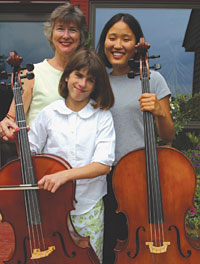
|
Diagnosed with Fetal Alcohol Syndrome (FAS) when she was adopted from a Russian orphanage at the age of 10 months, Sofia has struggled with multiple health problems throughout the course of her young life. Sofia's parents hoped that a medical student might learn that despite such difficulties, a patient like Sofia can thrive. The Fosters have come to realize that the relationship is just as valuable for Sofia.
"Sofia is working as hard as she can to stay in this world and be a part of it," says Carol Foster, Sofia's mother. "She is a beautiful spirit, but friendships don't come easily because of her disability. Calls from Rebekah are the highlight of Sofia's week or month."
Through these calls, and the time she spends with Sofia and her family, Kim has learned that Carol Foster worries about Sofia being able to maintain her self-esteem, particularly because FAS children have a high rate of suicide. Carol Foster often feels as though doctors treat Sofia as a specimen, and she hopes to change this by sharing Sofia with the world.
"FAS kids are smart enough to know they're different, but they have no power to change their behavior," explains Foster. "We are trying to be positive about Sofia and have her stay in a proud place."
Carol Foster felt that participating in the Patient Partnership Program would be one way to help Sofia maintain her dignity, by teaching a future physician about her life beyond the diagnosis of FAS. In turn, Foster has seen Kim become sensitive to Sofia's humanity, as she has viewed Sofia both as an individual and a member of a family.
In this way, Kim has played a large role in boosting Sofia's self-esteem, particularly by sharing one of her passions, music, with Sofia. Having worked in a children's music therapy program before she started medical school, Kim jumped at Carol Foster's suggestion that Sofia start playing a stringed instrument in order to enjoy the vibratory and auditory stimulus it would offer. This past summer, Kim worked to prepare Sofia for the cello lessons she begins this fall at school. By midsummer, Sofia was well on her way to mastering the bowing and fingering skills Kim was teaching her.
"It's nice that I can share music with Sofia," says Kim. "It's so healthy because it gives children such a nice balance to life, and it gives them discipline because they have to practice every day. It's wonderful for Sofia to be able to feel music, appreciate music, and make music herself, and it's neat that she can have this outlet like other children."
In addition to playing music with Sofia, Kim has spent time with her engaging in physical activities that Sofia enjoys—including swimming, jumping on the trampoline, and using the Dartmouth pottery studio. And so that she can understand how Sofia's dayto- day activities are affected by medical concerns, Kim has attended some of Sofia's occupational therapy and pediatric appointments as well.
At these appointments, both Carol Foster and Kim have learned that working with a doctor to address Sofia's medical problems involves creating a partnership similar to the one that Kim and Sofia have developed. Carol Foster sees that a doctor-patient relationship is about trust and mutual respect. In turn, Kim has offered this and more to the Foster family.
"Rebekah is compassionate and sensitive to kids like Sofia. She is going to make a terrific doctor because I've learned that she cares about all different kinds of kids," says Foster. "She sees that everyone is a real human being, no matter what their disability is. Some people have a fear of getting too close to someone who is too different, and they shy away. When you work with kids who have disabilities, you become bigger and more inclusive in your thinking."
Kim also has enjoyed the friendship that the Foster family has offered as she has settled into the Upper Valley. "The great thing about this is that coming to medical school, you're just a student. But now I'm part of a family here. It's amazing how generous the Foster family is, the way they do things like invite me over to dinner to share with them. You could go four years to medical school here and feel like you didn't connect with anyone. In this program, you get to know people and they get to know you as a friend, not just as someone with medical knowledge."
Kim also agrees with Foster that the experience has helped her learn to see how a child is a member of a family. In addition, she's learned how much effort it takes by both children and families to deal with a complex, chronic health condition. Kim remembers that when Sofia began reading, she and the Fosters appreciated the milestone especially deeply because doctors had told Sofia's parents that she would never be able to read. Kim also has watched Sofia's siblings create an encouraging environment in which she can grow and learn.
In fact, Kim hopes that if she has children of her own one day, Carol Foster will be able to give her some advice about how to raise them well.
"More than anything, this experience made me realize that having a child with a lot of medical needs is a lot of work," Kim concludes. "Labels or medical diagnoses make things so much harder for people. At the same time, I can see how dealing with those things can be one of the most enriching experiences in life. Sofia has made [her parents] into better people, people who are better able to appreciate simple pleasures in life."
A "cool" older friend
The 22 silent second-graders were jittery with anticipation by the time 30-year-old Roy Wade, Jr., a second-year Dartmouth medical student, entered their classroom with eight-yearold Rowan Dunfey, one of their classmates. The class had reason to be excited—for the next 40 minutes, Wade treated them to a fact-filled but fun lecture about the metabolism and pathology of diabetes and even offered a bonus explanation about why urine is yellow.
As Wade concluded his talk and asked for questions, Rowan peered up eagerly at the man twice his size. "Aren't you going to tell them about your Ph.D., too?" the second-grader whispered loudly.
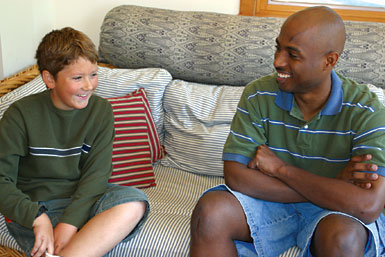
|
|
Eight-year-old Rowan Dunfey may be mature enough to give himself his own insulin shots, but he's still a kid—whether he's playing with his dog, Tansy, or talking sports with medical student Roy Wade. |

|
As Rowan recalls his experience taking Wade to school with him, he says proudly that "my class learned a lot." And, he adds, "it was also important for Roy to hear the questions that may be asked by patients. It was great because everyone asked a lot of questions, and we told him about ourselves. He talked about himself, and told stories also. I was really proud to have a friend who is much older and who is going to be a doctor."
Rowan, who was diagnosed with type I diabetes three years ago, may be proud of Wade's Ph.D. in microbiology and prospective M.D. But he has also enjoyed the personal nature of their relationship through DMS's Patient Partnership Program. Over the course of Wade's first year at Dartmouth, the two developed a brotherly friendship that extended beyond an exchange of information about living with diabetes.
Throughout the winter, Rowan had several dinner dates with Wade, attended an a cappella concert at the Medical School, and spent lots of time just bonding. "I got to do lots of cool things with him," says Rowan. "I really didn't feel uncomfortable in any way that he was older or that he didn't have diabetes. I think he is going to be a great doctor, because I have a sense that he has a great memory and he answers questions very well. He seems to remember everything that he's learned, and that's definitely not something I can do."
Although Rowan emphasizes "how smart" Wade is and recounts what Wade has taught him about science, Wade himself has enjoyed their less academic moments—playing catch in the backyard and exchanging sports stories. Through such activities, he has become very close to Rowan and learned that families of children with chronic illnesses are much like other families. At the same time, he's come to understand that doctors must be sensitive to the special needs that children like Rowan may have.
Although Wade has a grandmother with type II diabetes, he says that hearing Rowan talk about his insulin pump opened his eyes to the disease in a new way. Wade says he never understood what his grandmother had to go through to take insulin every day. He has also come to understand that doctors can give seemingly simple orders that are cumbersome for patients to follow.
"Now I see how sometimes doctors don't explain things appropriately," Wade says. "I see how this affects Rowan's life, and I see how this could affect my grandmother's life as well. Rowan's parents have to think about how to fit [treatments] in a schedule that doctors often ignore when they say he has to take his medication at a certain time." As a result, Wade feels he's learned "how to explain things better. I'll sit back and take the time to think about how my patients will implement what I'm saying into their lives."
He understands, too, that doctors "need to let our patients talk and listen to their opinions. . . . We might not always know the best thing for our patients—they might know it themselves. We must take each patient as an individual and figure out individual plans to help them find the results they want."
Wade admits that his strong background in research may lead him to see things through the lens of science. He feels that the Patient Partnership Program, by giving him insight into a patient's struggle with medical issues over the course of time, has reinforced the humanity of medicine. Not only has he learned that he will be treating real people rather than abstract cases, but he now realizes that every pediatric patient has parents who don't want their child to get hurt.
Patrick and Amy Dunfey, Rowan's parents, agree that the Patient Partnership Program has given Wade a fuller picture of what it's like for a family to deal with a diabetic child. "Although overall we have had positive experiences with doctors," Patrick Dunfey explains, "there are times when you notice that the doctor makes better connections with your child than [do] other doctors. Making this connection makes all the difference in the world. If this connection isn't made, it can be very alienating. I can't imagine something that could be more difficult on a child."
Furthermore, the Dunfeys believe that they as a family have benefited from having a future doctor connect with their son. Because Rowan often has little chance to establish long-term relationships with the many specialists he sees, the Dunfeys are pleased that Wade has been able to demystify the barrier that sometimes can exist between patients and doctors.
Patrick Dunfey says that they have particularly enjoyed watching Rowan explain his condition and his routine to Wade. Rowan has always been practical and forthright about his diabetes with friends and family members, says Patrick Dunfey, but he's noticed that his son sometimes assumes a different demeanor with doctors. Wade, however, "blended friendship with medicine," says Patrick Dunfey, becoming involved with Rowan's care as a friend and also as someone interested in science.
For his part, Wade feels that the Dunfeys have taught him some valuable lessons about parenting and about caring for a child with a chronic illness. He is particularly impressed with the way the Dunfeys have given Rowan ownership of his disease, teaching him to calculate his own insulin dosages and to give himself his own shots. He also admires the fact that they haven't allowed Rowan to feel embarrassed about having an illness.
"The key to being whole is acknowledging something like this, and treating it, and being well," Wade concludes.
An outlet at a stressful time
Two children under the age of three, plus a new baby on the way: that sounds like a daunting enough situation for any young mother. Managing a high-risk pregnancy and doctorordered bed rest on top of that was impossible for Elaine Johnson to imagine—until it happened to her.
But adding in second-year DMS student Krista Heydt made Johnson's life a tiny bit more manageable. When Heydt became the young mother's student partner a year ago, Johnson gained the support that she thought she would never find after a move halfway across the country during what she calls the most physically and emotionally demanding time of her life.
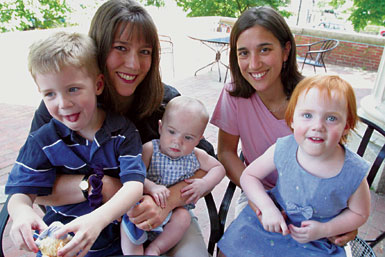
|
|
Elaine Johnson (below and at left above) had her hands full even before being diagnosed with a highrisk pregnancy—but her relationship with medical student Krista Heydt (in pink) made a difference. |
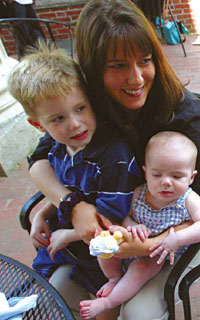
|
"I was constantly overwhelmed, and Krista was someone I could confide in," explains Johnson. "It was a very trying experience having two kids that needed their mom, and not having family around to help. For me, Krista was that link. It really helped to have someone on the outside who was objective and unbiased, and I could safely talk to and express things to. I feel very much indebted to her, and I don't know if that's something she realizes. I felt more connected to her than to my doctors."
Although Johnson's two previous pregnancies had also been high-risk—she had contractions if she merely got out of bed to urinate—she spent most of those pregnancies in the hospital, supported by family and friends in her home state of Minnesota. After two healthy deliveries— Alec, who is now four years old, and Kara, now two and a half—Johnson became pregnant again. This time, however, she was living in New Hampshire.
As Heydt helped Johnson negotiate the Upper Valley's obstetrical world, she learned more than she ever could have imagined about the challenges that a patient like Johnson faces. Heydt came to understand the discrepancy between mandatory bed rest and realistic strategies that fit with a patient's life.
Heydt acknowledges that it can be exceedingly difficult for doctors to identify practical solutions for situations such as Johnson's. However, she says Johnson has helped her to truly understand that the implications of a patient's diagnosis, and a doctor's orders, go far beyond a 15- to 20-minute office consultation.
"I want to be sensitive to that, and at least understand that it is difficult and find ways to make it more plausible for the patient," says Heydt. "I would hope that patients will feel comfortable opening up to me, because now I understand how important it is to help them find the resources they need."
As a result of her experiences with Johnson, Heydt says that she feels better equipped to be attentive to her patients than she might have been previously.
She realizes that what a doctor suggests may not even be the best thing for a patient. In Johnson's case, Heydt would have liked to strategize ways for her to safely be on her feet more hours each day. She also feels that it would be helpful to acknowledge that while pregnancy is a happy period for many women, it can be very stressful for women like Johnson who have faced a high risk of miscarriage three times.
As the year and Johnson's pregnancy progressed, Heydt developed a deep friendship with the young mother and witnessed the strength of the Johnson family. She says that they did a "beautiful job" handling a situation that might sound simple but is extremely complicated in reality. Heydt now understands how hard families work to execute a doctor's orders between their office visits, and Johnson agrees that the perspective Heydt gained never could have been learned in the classroom.
"I told her what I was thinking, what I was dealing with, how it affected me, and how I was coping with it, how I was enduring and persevering, and that's what I think I probably gave to her. I would tell her what I was feeling good about, and what I was having a hard time with. I was scared half to death all the time, so it really helped to share that with somebody," Johnson says.
At other times, Heydt helped Johnson with housework or played with Alec and Kara, who eagerly anticipated the medical student's weekly visits. Johnson commends Heydt's natural manner with children and says that her two kids looked forward to the playtime as much as she looked forward to the companionship.
While supporting Johnson during the months of her pregnancy, Heydt became so close to her that Johnson's husband called her on a Saturday night in February to come watch their third baby be born. Heydt said it was "exciting and amazing" to be there to support Johnson through that momentous event.
After the baby (another boy, Sean) was born, Heydt and Johnson's relationship took an entirely new turn. Johnson continued to lean on Heydt for support as she and her husband received the news that their new son had a lung defect and needed surgery to remove part of the organ. At the same time, Johnson and her husband were trying to support their mothers, both of whom had just been diagnosed with colon cancer.
"We were faced with a lot, and [Krista's] emotional support was so valuable," says Johnson. "I don't know if the outcome would have been the same with someone else, because I felt like I connected with Krista in a special way. It was neat that Krista was there in any way that she could help."
Johnson hopes that other women coping with high-risk pregnancies will have the opportunity to share this kind of experience with a medical student. Not only does Johnson know there would be a direct benefit to the women participating in such a relationship, but she feels that many future pregnant women will benefit if all doctors gain a better understanding of women's obstetrical experiences— from morning sickness to labor pains to the problems related to high-risk pregnancies.
"I know I'm not the only woman who has felt this way," Johnson says. "There are other women in the community who are going through what I went through. . . . I would like it to be known that for women in highrisk pregnancies in our area, there's a program like this for them."
Both the author and the photographer for this feature are (or were until very recently)—like most of their subjects here—Dartmouth students. Writer Katrina Mitchell is a second-year medical student as well as a regular contributor to Dartmouth Medicine and a newly appointed member of the magazine's Editorial Board. At her undergraduate alma mater, Bowdoin College, she was an intern in the news office and served as a peer writing mentor. Photographer Alexios Monopolis graduated in June from Dartmouth College and is about to leave for Greece on a Fulbright grant to do research on environmental diplomacy and to photograph the region's ecosystems. In the fall of 2004, he hopes to enter an individualized Ph.D. program on photography and social change.
If you would like to offer any feedback about this article, we would welcome getting your comments at DartMed@Dartmouth.edu.
